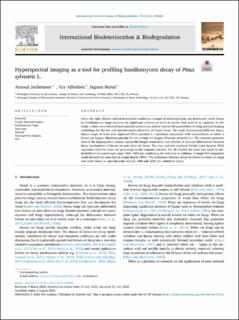| dc.contributor.author | Jochemsen, Arnoud | |
| dc.contributor.author | Alfredsen, Gry | |
| dc.contributor.author | Burud, Ingunn | |
| dc.date.accessioned | 2022-10-31T13:45:39Z | |
| dc.date.available | 2022-10-31T13:45:39Z | |
| dc.date.created | 2022-09-16T10:58:39Z | |
| dc.date.issued | 2022-08-02 | |
| dc.identifier.citation | International Biodeterioration & Biodegradation. 2022, 174 . | en_US |
| dc.identifier.issn | 0964-8305 | |
| dc.identifier.uri | https://hdl.handle.net/11250/3029171 | |
| dc.description.abstract | Given the right climatic and environmental conditions, a range of microorganisms can deteriorate wood. Decay by basidiomycete fungi accounts for significant volumes of wood in service that need to be replaced. In this study, a short-wave infrared hyperspectral camera was used to explore the possibilities of using spectral imaging technology for the fast and non-destructive detection of fungal decay. The study encompassed different degradation stages of Scots pine sapwood (Pinus sylvestris L.) specimens inoculated with monocultures of either a brown rot fungus (Rhodonia placenta Fr.) or a white rot fungus (Trametes versicolor L.). The research questions were if the hyperspectral camera can profile fungal wood decay and whether it also can differentiate between decay mechanisms of brown rot and white rot decay. The data analysis employed Partial Least Squares (PLS) regression with the mass loss percentage as the response variable. For all models, the mass loss could be predicted from the wavelength range 1460–1600 nm, confirming the reduction in cellulose. A single PLS component could describe the mass loss to a high degree (90%). The distinction between decay by brown or white rot fungi was made based on spectral peaks around 1680 and 2240 nm, related to lignin. | en_US |
| dc.language.iso | eng | en_US |
| dc.publisher | Elsevier Ltd. | en_US |
| dc.rights | Navngivelse 4.0 Internasjonal | * |
| dc.rights.uri | http://creativecommons.org/licenses/by/4.0/deed.no | * |
| dc.title | Hyperspectral imaging as a tool for profiling basidiomycete decay of Pinus sylvestris L. | en_US |
| dc.title.alternative | Hyperspectral imaging as a tool for profiling basidiomycete decay of Pinus sylvestris L. | en_US |
| dc.type | Peer reviewed | en_US |
| dc.type | Journal article | en_US |
| dc.description.version | publishedVersion | en_US |
| dc.rights.holder | © 2022 The Authors | en_US |
| dc.source.pagenumber | 10 | en_US |
| dc.source.volume | 174 | en_US |
| dc.source.journal | International Biodeterioration & Biodegradation | en_US |
| dc.identifier.doi | 10.1016/j.ibiod.2022.105464 | |
| dc.identifier.cristin | 2052400 | |
| dc.relation.project | Norges forskningsråd: 281018 | en_US |
| dc.relation.project | Norges forskningsråd: 297899 | en_US |
| dc.relation.project | EC/H2020/773324 | en_US |
| dc.source.articlenumber | 105464 | en_US |
| cristin.ispublished | true | |
| cristin.fulltext | original | |
| cristin.fulltext | original | |
| cristin.qualitycode | 1 | |

